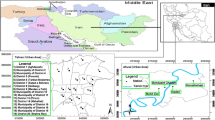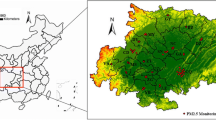Abstract
This study is aimed to investigate spatial and seasonal variations of air pollutants in Istanbul between 2007 and 2017. Target air pollutants were carbon monoxide, particulate matter, sulfur dioxide, nitrogen oxides, and ozone. Air quality data of the city of Istanbul were obtained from 31 continuous air quality monitoring stations located at the Anatolian and the European Sides of the city. Spatial and temporal variations of the air pollutants were assessed by statistical methods (p < 0.05). According to the results of this study, all air pollutants showed seasonal variations and all parameters were found to be higher during the heating periods than other periods (p < 0.05), except for ozone. The annual average values of carbon monoxide, particulate matter with diameter of less than 10 µm, sulfur dioxide, ozone, and nitrogen dioxide (except for nitrogen dioxide levels measured in 2017) concentrations were below the national limit values in all stations between 2007 and 2017. In terms of yearly variation of the air pollutants, carbon monoxide and ozone showed statistically significant increasing trends (p < 0.001). Overall, once ten-years average air quality data were compared with current air quality limit values which was effective since 2019, PM and NO2 may have limit exceedance problems in the next years. Moreover, levels of particulate matter with diameter of less than 2.5 µm were measured at 3 air quality monitoring stations, exceeded both World Health Organization and European Union limit values. Furthermore, positive correlations were found among the air pollutants (p < 0.001).









Similar content being viewed by others
Abbreviations
- AQMS:
-
Air quality monitoring station
- BTEX:
-
Benzene, toluene, ethylbenzene, xylenes
- CFR:
-
Code of federal regulation
- CO:
-
Carbon monoxide
- EU:
-
European Union
- F:
-
Factor
- HKDYY:
-
Turkish air quality evaluation and management regulation
- IB:
-
Istanbul metropolitan municipality
- MoE&U:
-
Ministry of environment and urbanization
- MTHM:
-
Marmara clean air center
- NO:
-
Nitrogen monoxide
- NO2 :
-
Nitrogen dioxide
- NOx:
-
Nitrogen oxides
- O3 :
-
Ozone
- PM:
-
Particulate matter
- PM10 :
-
Particulate matter with diameter of less than 10 µm
- PM2.5 :
-
Particulate matter with diameter of less than 2.5 µm
- SO2 :
-
Sulfur dioxide
- TÜV:
-
Technischer Überwachungsverein (International technical control company)
- US EPA:
-
United States Environmental Protection Agency
- WHO:
-
World Health Organization
References
Air Pollution Assessment and Management Regulation (HKDYY) (2008) O.J. date 06.06.2008, issue: 26898
Alkoy S, Dogru AO, Basarener M, Sahin U, Ulugtekin N, Seker DZ (2009) Determination of the epidemiological aspects of air pollution in Istanbul by utilizing GIS. Fresenius Environ Bull 18(1):117–122
Altwicker ER, Canter LW, Cha SS, Chuang KT, Liu DF, Ramachandran G, Raufer RK, Reist PC, Sanger et al (1999) Air pollution/Ch05. CRC Press, Boca Raton
Alver F, Saraç BA, Şahin ÜA (2018) Estimating of shipping emissions in the Samsun Port from 2010 to 2015. Atmos Pollut Res 9:822–828
Batur İ, Bayram IS, Koc M (2019) Impact assessment of supply-side and demand-side policies on energy consumption and CO2 emissions from urban passenger transportation: the case of Istanbul. J Clean Prod 219:391–410
Baykara M, Im U, Unal A (2019) Evaluation of impact of residential heating on air quality of megacity Istanbul by CMAQ. Sci Total Environ 651:1688–1697
Beelen R, Hoek G, Vienneau D (2013) Development of NO2 and NOx land use regression models for estimating air pollution exposure in 36 study areas in Europe The ESCAPE project. Atmos Environ 72:10–23
Bozyazi E, Incecik S, Mannaerts C, Brussel M (2000) Analysis and mapping of air pollution using a GIS approach: a case study of Istanbul. In: Longhurst JWS, Brebbia CA, Power H (eds) Air pollution, vol VIIII. Wessex Institute Technology, Cambridge, pp 431–440
Çapraz Ö, Efe B, Deniz A (2016) Study on the association between air pollution and mortality in İstanbul, 2007–2012. Atmos Pollut Res 7(1):147–154
Çapraz Ö, Deniz A, Doğan N (2017) Effects of air pollution on respiratory hospital admissions in İstanbul, Turkey, 2013 to 2015. Chemosphere 181:544–550
Elbir T, Mangir N, Kara M, Simsir S, Eren T, Ozdemir S (2010) Development of a GIS-based decision support system for urban air quality management in the city of Istanbul. Atmos Environ 44(4):441–454
Ercan Ö, Dincer F, Ceyal Ö (2019) Spatial and seasonal variations of atmospheric BTEX, sulfur dioxide, nitrogen dioxide, and ozone concentrations in Istanbul, and health risk assessment of BTEX. Environ Forensics 20(2):149–161
Ercelebi SG, Toros H (2009) extreme value analysis of istanbul air pollution data. CLEAN Soil Air Water 37(2):122–131
European Union (EU) (2016) Air quality standards. https://www.eea.europa.eu/themes/data-and-maps/figures/air-quality-standards-under-the
EVA (2020) EVA real estate appraisal consultancy. http://www.evagyd.com/haberler/Istanbulda-rakamlarla-konut-sektoru/571/
Flores RM, Kaya N, Eşer Ö, Saltan Ş (2017) The effect of mineral dust transport on PM10 concentrations and physical properties in Istanbul during 2007–2014. Atmos Res 197:342–355
Flores RM, Mertoğlu E, Özdemir H, Akkoyunlu BO, Demir G, Ünal A, Tayanç M (2020) A high-time resolution study of PM2.5, organic carbon, and elemental carbon at an urban traffic site in Istanbul. Atmos Environ 223:117241
Forbes (2019). https://www.forbes.com/sites/ericrosen/2019/09/04/the-worlds-most-visited-city-is-bangkok/#18b83aa2cd26
Gokce HB, Arıoğlu E, Copty NK, Onay TT, Gun B (2020) Exterior air quality monitoring for the Eurasia Tunnel in Istanbul, Turkey. Sci Total Environ 699:134312
Hapcioglu B, İssever H, Kocyigit E, Disci R, Vatansever S, Özdilli K (2006) The effect of air pollution and meteorological parameters on chronic obstructive pulmonary disease at an Istanbul hospital. Indoor Built Environ 15(2):147–153
Im U, Incecik S, Guler M, Tek A, Topcu S, Unal YS et al (2013) Analysis of surface ozone and nitrogen oxides at urban, semi-rural and rural sites in Istanbul, Turkey. Sci Total Environ 443:920–931
Incecik S (1986) Investigation of atmospheric conditions in Istanbul leading to air pollution episodes. Atmos Environ 30:2739–2749
Issever H, Disci R, Hapcioglu B, Vatansever S, Karan MA, Akkaya V, Erk O (2005) The effect of air pollution and meteorological parameters in Istanbul on hospital admissions for acute coronary syndrome. Indoor Built Environ 14(2):157–164
Istanbul Metropolitan Municipality (IBB) (2020) The Environment protection directorate measurement devices. https://havakalitesi.ibb.gov.tr/Icerik/hakkimizda/olcum-cihazlari
Jodeh S, Chakir A, Massad Y, Roth E (2020) Assessment of PM2.5, TVOCs, comfort parameters, and volatile organic solvents of paint at carpenter workshop and exposure to residential houses in Deir Ballout in Palestine. Int J Environ Sci Technol. https://doi.org/10.1007/s13762-020-02877-9
Kanakidou M, Mihalopoulos N, Kindap T, Im U, Vrekoussis M, Gerasopoulos E et al (2011) Megacities as hot spots of air pollution in East Mediterranean. Atmos Environ 45:1223–1235
Kilic A, Deniz C (2010) Inventory of shipping emissions in Izmit Gulf, Turkey. Environ Prog Sustain Energy 29(2):221–232
Kocak M, Theodosi C, Zarmpas P, Im U, Bougiatioti A, Yenigun O, Mihalopoulos N (2011) Particulate matter (PM10) in Istanbul: origin, source areas and potential impact on surrounding regions. Atmos Environ 45(38):6891–6900
Mentese S, Akça B (2020) Hot-spot summertime levels and potential sources of volatile organic compounds (VOC) on roads around Çanakkale and Kilitbahir harbors across Dardanelles strait. Atmos Pollut Res. https://doi.org/10.1016/japr202007028
Mentese S, Mirici NA, Elbir T, Palaz E, Mumcuoğlu DT, Cotuker O, Bakar C, Oymak S, Otkun MT (2020a) A long-term multi-parametric monitoring study: indoor air quality (IAQ) and the sources of the pollutants, prevalence of sick building syndrome (SBS) symptoms, and respiratory health indicators. Atmos Pollut Res. https://doi.org/10.1016/j.apr.2020.07.016
Mentese S, Mirici NA, Elbir T, Tuygun GT, Bakar C, Otkun MT, Omak S (2020b) A comprehensive assessment of ambient air quality in Çanakkale city: emission inventory, air quality monitoring, source apportionment, and respiratory health indicators. Atmos Pollut Res. https://doi.org/10.1016/japr202007005
Menteşe S, Rad AY, Arisoy M, Gullu G (2012) Multiple comparisons of organic, microbial, and fine particulate pollutants in typical indoor environments: diurnal and seasonal variations. J Air Waste Manag Assoc 62:1380–1393
Mihelcic JR, Zimmerman JB (2010) Environmental engineering: fundamentals, sustainability, design. Wiley, New York, p 695
Ministry of Culture and Tourism (2019) Istanbul tourism statistics—2019. https://istanbul.ktb.gov.tr/TR-243067/istanbul-turizm-istatistikleri—2019.html
Ministry of Environment and Urbanization (MoE&U) (2015) Environmental status report of Istanbul city—2015. https://webdosya.csb.gov.tr/db/Istanbul/icerikbelge/icerikbelge43894.pdf
Ministry of Environment and Urbanization (MoE&U) (2018) Environmental status report of Istanbul for 2017
Ministry of Transport (2018) Maritime affairs and communication. https://atlantis.udhb.gov.tr/istatistik/gemi_gecis_2018.aspx
Onat B, Şahin ÜA, Bayat C (2012) Assessment of particulate matter in the urban atmosphere: size distribution, metal composition and source characterization using principal component analysis. J Environ Monit 14(5):1400–1409
Onat B, Şahin ÜA, Uzun B, Akın Ö, Özkaya F, Ayvaz C (2019) Determinants of exposure to ultrafine particulate matter, black carbon, and PM2. 5 in common travel modes in Istanbul. Atmos Environ 206:258–270
Ozcan HK (2012) Long term variations of the atmospheric air pollutants in Istanbul city. Int J Environ Res Public Health 9(3):781–790
Ozdemir H, Pozzoli L, Kindap T, Demir G, Mertoglu B, Mihalopoulos N et al (2014) Spatial and temporal analysis of black carbon aerosols in Istanbul megacity. Sci Total Environ 473:451–458
Rao ST, Zurbenko IG (1994) Detecting and tracking changes in ozone air quality. J Air Waste Manag Assoc 44s:1089–1092
Sahin ÜA, Onat B, Akın Ö, Ayvaz C, Uzun B, Mangır N et al (2020) Temporal variations of atmospheric black carbon and its relation to other pollutants and meteorological factors at an urban traffic site in Istanbul. Atmos Pollut Res 11(7):1051–1062
Saral A (2011) Hava Kirliliği Nedir, Ülkemizdeki Durumdan Kesitler. Bilim ve Aklın Aydınlığında Eğitim, 34–41
Sumen M, Oktar A, Mangir N, Ozcelik R (2005) Actions taken in Istanbul towards the aim of preventing air pollution. In: Proceedings of the third international symposium on air quality management at urban, regional and global scales. 26–30 September 2005, Istanbul, pp 1418–1429
Toros H, Erdun H, Çapraz Ö, Özer B, Daylan E, Öztürk A (2013) Air pollution and quality levels in metropolitans of Turkey for sustainable life. Avrupa Bilim Teknol Derg 1(1):12–18
Turkish Statistics Institute (TÜİK) (2018) Population statistics. http://www.tuik.gov.tr/PreTablo.do?alt_id=1059
Turkish Statistics Institute (TÜİK) (2020) House sales for Istanbul City https://biruni.tuik.gov.tr/medas/?kn=73&locale=tr
Unal YS, Incecik S, Borhan Y, Mentes S (2000) Factors influencing the variability of SO2 concentrations in Istanbul. J Air Waste Manag Assoc 50:75–84
Unal YS, Toros H, Deniz A, Incecik S (2011) Influence of meteorological factors and emission sources on spatial and temporal variations of PM10 concentrations in Istanbul metropolitan area. Atmos Environ 45(31):5504–5513
US EPA (2020) National air quality standards (NAAQS Table). https://www.epa.gov/criteria-air-pollutants/naaqs-table
WHO (2018) Outdoor air quality and health. https://www.who.int/news-room/fact-sheets/detail/ambient-(outdoor)-air-quality-and-health
World City Populations (2020) https://worldpopulationreview.com/world-cities/
Yurtseven E, Vehid S, Bosat M, Köksal S, Yurtseven CN (2018) Assessment of ambient air pollution in istanbul during 2003–2013. Iran J Public Health 47(8):1137
Zhang H, Wang Y, Hu J, Ying Q, Hu X-M (2015) Relationships between meteorological parameters and criteria air. Environ Res 140:242–254
Acknowledgments
This study has not been supported financially neither is a part of a broader project.
Author information
Authors and Affiliations
Corresponding author
Ethics declarations
Conflict of interest
The authors declare that they have no conflict of interest.
Ethical approval
This article does not contain any studies with human participants or animals performed by any of the authors.
Additional information
Editorial responsibility: Mohamed F. Yassin.
Rights and permissions
About this article
Cite this article
Mentese, S., Ogurtani, S.Ö. Spatial and temporal look at ten-years air quality of Istanbul city. Int. J. Environ. Sci. Technol. 19, 925–938 (2022). https://doi.org/10.1007/s13762-020-03061-9
Received:
Revised:
Accepted:
Published:
Issue Date:
DOI: https://doi.org/10.1007/s13762-020-03061-9




